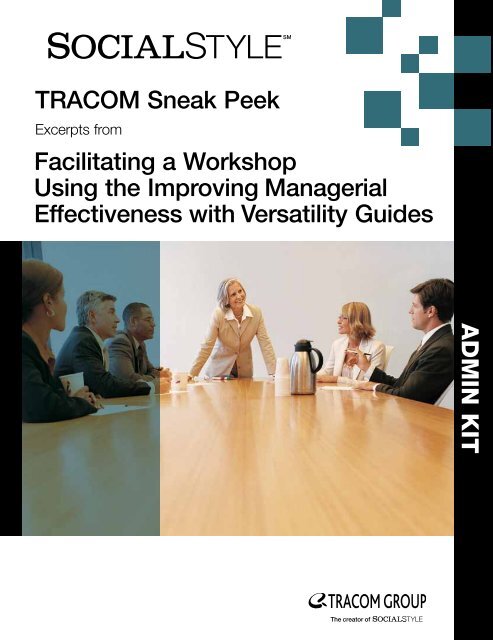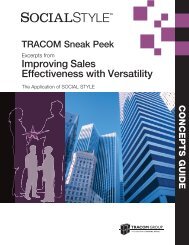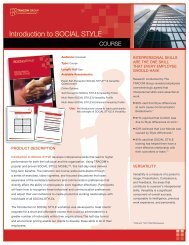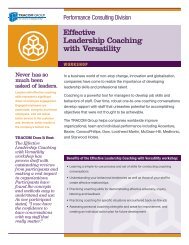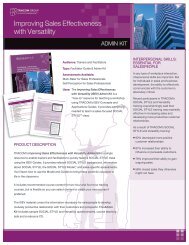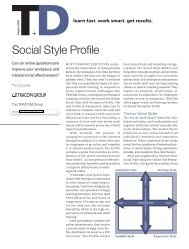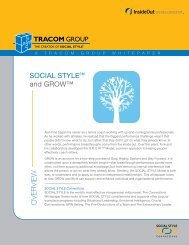TRACOM Group Managerial Admin Kit Sneak Peek - The TRACOM ...
TRACOM Group Managerial Admin Kit Sneak Peek - The TRACOM ...
TRACOM Group Managerial Admin Kit Sneak Peek - The TRACOM ...
Create successful ePaper yourself
Turn your PDF publications into a flip-book with our unique Google optimized e-Paper software.
<strong>TRACOM</strong> <strong>Sneak</strong> <strong>Peek</strong><br />
Excerpts from<br />
Facilitating a Workshop<br />
Using the Improving <strong>Managerial</strong><br />
Effectiveness with Versatility Guides<br />
<strong>Admin</strong> kit
Table of Contents<br />
Iintroduction . . . . . . . . . . . . . . . . . . . . . . . . . . . . . . . . . . . . . . . . . . . . . . . . . . . . . . . . . . . . . . . . . 1<br />
History<br />
Workshop Overview . . . . . . . . . . . . . . . . . . . . . . . . . . . . . . . . . . . . . . . . . . . . . . . . . . . . . . . . . . 1<br />
Roots of the SOCIAL STYLE Model . . . . . . . . . . . . . . . . . . . . . . . . . . . . . . . . . . . . . . . . . . . . . 2<br />
<strong>The</strong> Model Comes Together . . . . . . . . . . . . . . . . . . . . . . . . . . . . . . . . . . . . . . . . . . . . . . . . . . . . . 2<br />
Workshop Materials . . . . . . . . . . . . . . . . . . . . . . . . . . . . . . . . . . . . . . . . . . . . . . . . . . . . . . . . . . 3<br />
Workshop Materials . . . . . . . . . . . . . . . . . . . . . . . . . . . . . . . . . . . . . . . . . . . . . . . . . . . . . . . . . . . 3<br />
Two-Hour Version And Four-Hour Version . . . . . . . . . . . . . . . . . . . . . . . . . . . . . . . . . . . . . . . . . 3<br />
<strong>The</strong> Self-Perception Questionnaires . . . . . . . . . . . . . . . . . . . . . . . . . . . . . . . . . . . . . . . . . . . . . . 4<br />
<strong>The</strong> Improving <strong>Managerial</strong> Effectiveness With Versatility Concepts Guide . . . . . . . . . . . . . . . 4<br />
Resource CD . . . . . . . . . . . . . . . . . . . . . . . . . . . . . . . . . . . . . . . . . . . . . . . . . . . . . . . . . . . . . . . . 5<br />
Additional Materials Available For Supplemental Exercises . . . . . . . . . . . . . . . . . . . . . . . . . . . 6<br />
Preparation For <strong>The</strong> Workshop . . . . . . . . . . . . . . . . . . . . . . . . . . . . . . . . . . . . . . . . . . . . . . . . . . 7<br />
Additional Facilitator Preparation Materials . . . . . . . . . . . . . . . . . . . . . . . . . . . . . . . . . . . . . . . . 7<br />
Suggested Workshop Timing . . . . . . . . . . . . . . . . . . . . . . . . . . . . . . . . . . . . . . . . . . . . . . . . . . . 8<br />
Suggested Timing For <strong>The</strong> Two-Hour Workshop . . . . . . . . . . . . . . . . . . . . . . . . . . . . . . . . . . . . 8<br />
Suggested Timing For <strong>The</strong> Four-Hour Expanded Workshop . . . . . . . . . . . . . . . . . . . . . . . . . . . 9<br />
Developing <strong>Managerial</strong> Effectiveness with Style Workshop—Two-Hour Version . . . . . . . . . . 10<br />
Section I: Introduction, Overview, And Self-Perception Questionnaires . . . . . . . . . . . . . . . . . 11<br />
Section II: SOCIAL STYLE Fundamentals . . . . . . . . . . . . . . . . . . . . . . . . . . . . . . . . . . . . . . . 17<br />
Section III: Improving Your Effectiveness & Versatility . . . . . . . . . . . . . . . . . . . . . . . . . . . . . . 53<br />
Optional Exercises — Four-Hour Version . . . . . . . . . . . . . . . . . . . . . . . . . . . . . . . . . . . . . . . . . 55<br />
Strengths and Weaknesses of Each Style . . . . . . . . . . . . . . . . . . . . . . . . . . . . . . . . . . . . . . . . . . 60<br />
Taking my Growth Action . . . . . . . . . . . . . . . . . . . . . . . . . . . . . . . . . . . . . . . . . . . . . . . . . . . . . 61<br />
Identify the Facilitator's Style . . . . . . . . . . . . . . . . . . . . . . . . . . . . . . . . . . . . . . . . . . . . . . . . . . 62<br />
Style Observation Rules . . . . . . . . . . . . . . . . . . . . . . . . . . . . . . . . . . . . . . . . . . . . . . . . . . . . . . . 63<br />
Estimating a Direct Report's Style . . . . . . . . . . . . . . . . . . . . . . . . . . . . . . . . . . . . . . . . . . . . . . . 64<br />
Style Forum . . . . . . . . . . . . . . . . . . . . . . . . . . . . . . . . . . . . . . . . . . . . . . . . . . . . . . . . . . . . . . . . 66<br />
Knowing What a Direct Report Accepts/Rejects . . . . . . . . . . . . . . . . . . . . . . . . . . . . . . . . . . . . 67<br />
Helping Your Direct Reports Increase <strong>The</strong>ir Productivity . . . . . . . . . . . . . . . . . . . . . . . . . . . . . 68<br />
Developing Actions Toward Others Using the Style Dial . . . . . . . . . . . . . . . . . . . . . . . . . . . . . 70<br />
Communicating With My Direct Reports—with Style . . . . . . . . . . . . . . . . . . . . . . . . . . . . . . . 71<br />
Delegating to Direct Reports—with Style . . . . . . . . . . . . . . . . . . . . . . . . . . . . . . . . . . . . . . . . . 73<br />
© <strong>The</strong> <strong>TRACOM</strong> Corporation, All Rights Reserved.<br />
FACILITATOR<br />
GUIDE<br />
I
Introduction<br />
WORKSHOP OVERVIEW<br />
<strong>The</strong> SOCIAL STYLE Model is easy to understand and apply. It provides an effective framework and<br />
specifi c techniques for helping people to improve their interpersonal managerial skills.<br />
This guide provides you, the workshop leader, with the necessary information for conducting either a<br />
basic or expanded workshop using <strong>TRACOM</strong>’s Improving <strong>Managerial</strong> Effectiveness with Versatility<br />
Guides and accompanying SOCIAL STYLE and Versatility Questionnaires. <strong>The</strong> workshop focuses on<br />
the essentials of Style and incorporates well over forty years of collective instructional and facilitative<br />
experience with the SOCIAL STYLE Model.<br />
To orient you to the Style legacy, this guide begins with a brief history of the SOCIAL STYLE Model.<br />
Next, it provides a game plan for successfully conducting both a basic and an expanded version of the<br />
workshop. <strong>The</strong> guide suggests instructional options depending on the amount of time set aside for<br />
training. Finally, the guide includes Supporting Research about the SOCIAL STYLE Model to enrich<br />
your knowledge of Style and Versatility and to prepare you for many of the questions typically asked by<br />
participants.<br />
This guide lays out instructions and activities in a way to give you maximum fl exibility in delivering<br />
the program elements. It is up to you to decide what level of understanding and skill development are<br />
necessary for your participants and to adjust the presentation accordingly.<br />
© <strong>The</strong> <strong>TRACOM</strong> Corporation, All Rights Reserved.<br />
FACILITATOR<br />
GUIDE<br />
1
Workshop Materials<br />
WORKSHOP MATERIALS<br />
© <strong>The</strong> <strong>TRACOM</strong> Corporation, All Rights Reserved.<br />
FACILITATOR<br />
GUIDE<br />
<strong>The</strong> following pages explain how to use the materials that are available for delivering this workshop. By<br />
carefully reviewing these materials, you will be able to select the workshop elements most appropriate for<br />
your participants and the time you have available for training.<br />
Specifi cally, this guide covers the following items:<br />
■ Self-Perception Questionnaires<br />
■ Improving <strong>Managerial</strong> Effectiveness with Versatility Concepts Guide<br />
■ Resource CD (PowerPoint slides, participant handouts, marketing materials)<br />
■ Optional exercises<br />
■ Additional resource materials available for purchase<br />
■ Additional facilitator preparation materials<br />
TWO-HOUR VERSION AND FOUR-HOUR VERSION<br />
This facilitator guide was designed to provide you quite a bit of fl exibility in delivering this program.<br />
You will fi nd that we have provided a suggested workshop outline and timing for both a two-hour basic<br />
workshop and a four-hour expanded workshop.<br />
Two-Hour Workshop<br />
<strong>The</strong> two-hour workshop is designed to provide an introduction to SOCIAL STYLE and Versatility.<br />
<strong>The</strong> workshop teaches your participants about the fundamental concepts of behavior versus personality,<br />
provides insight into the four SOCIAL STYLES, and demonstrates the impact that their SOCIAL STYLE<br />
and Versatility have on others, such as their direct reports.<br />
Four-Hour Workshop<br />
<strong>The</strong> four-hour workshop expands the participants' understanding of the concepts covered in the two-hour<br />
version through the use of a variety of hands-on experiential exercises that you may choose from. <strong>The</strong>re is<br />
also signifi cant additional content added to the program regarding the application of SOCIAL STYLE and<br />
Versatility concepts in the skills and tasks associated with managing people.<br />
3
Suggested Workshop Timing<br />
SUGGESTED TIMING FOR THE TWO-PLUS-HOUR WORKSHOP<br />
8<br />
SEGMENT<br />
TIME<br />
ACTIVITY<br />
BASIC VERSION<br />
2 hrs.<br />
0:10<br />
Section I: Introduction/Self-Perception Questionnaires<br />
Introduction, Overview and Objectives 0:10<br />
0:10 <strong>The</strong> SOCIAL STYLE and Versatility Self-Perception<br />
Questionnaires<br />
Section II: SOCIAL STYLE Fundamentals<br />
0:20<br />
0:05 Behavior vs. Personality 0:25<br />
0:05 Say and Do Behaviors 0:30<br />
0:20 Dimensions of Behavior<br />
SECTION III: SOCIAL STYLE Model<br />
0:50<br />
0:05 <strong>The</strong> Four SOCIAL STYLE Positions 0:55<br />
0:05 Your SOCIAL STYLE Position 1:00<br />
0:20 Exercise: Learning More About Your Style 1:20<br />
0:05 SOCIAL STYLE Summary 1:25<br />
0:05 Key Characteristics<br />
SECTION IV: Tension Management<br />
1:30<br />
0:15 Tension Management<br />
SECTION V: Versatility<br />
1:45<br />
0:05 Managing in the Third Dimension 1:50<br />
0:05 <strong>The</strong> Four Sources of Versatility 1:55<br />
0:05 Your Versatility Score 2:00<br />
0:05 Improving Your Effectiveness with your Direct Reports 2:05<br />
0:05 Program Summary and Next Steps 2:10<br />
Remember: you can add or delete optional exercises to meet the needs of your participants.<br />
Facilitator's Guide: Enhancing Your <strong>Managerial</strong> Skills with SOCIAL STYLE
Suggested Workshop Timing<br />
SUGGESTED TIMING FOR THE FOUR-PLUS-HOUR EXPANDED WORKSHOP<br />
SEGMENT<br />
TIME<br />
© <strong>The</strong> <strong>TRACOM</strong> Corporation, All Rights Reserved.<br />
ACTIVITY<br />
EXPANDED VERSION<br />
4 hrs.<br />
0:10<br />
Section I: Introduction/Self-Perception Questionnaires<br />
Introduction, Overview and Objectives 0:10<br />
0:10 <strong>The</strong> SOCIAL STYLE and Versatility Self-Perception<br />
Questionnaires<br />
Section II: SOCIAL STYLE Fundamentals<br />
0:20<br />
0:05 Behavior vs. Personality 0:25<br />
0:05 Observable Say and Do Behaviors 0:30<br />
0:20 Dimensions of Behavior, Assertiveness, Responsiveness<br />
Section III: SOCIAL STYLE Model<br />
0:50<br />
0:05 <strong>The</strong> Four SOCIAL STYLE Positions 0:55<br />
0:05 Your SOCIAL STYLE Position 1:00<br />
0:20 Exercise: Learning More About Your Style 1:20<br />
0:05 SOCIAL STYLE Summary 1:25<br />
0:05 Key Characteristics 1:30<br />
0:20 Optional: Taking My Growth Action<br />
SECTION IV: Tension Management<br />
1:50<br />
0:15 Tension Management 2:05<br />
0:30 Optional: Style Forum or Strengths & Weaknesses of My Style 2:35<br />
0:10 Break 2:45<br />
0:10 Optional: Style Observation Rules 2:55<br />
0:15 Optional: Estimating a Direct Report's Style<br />
SECTION V: Versatility<br />
3:10<br />
0:05 Managing in the Third Dimension 3:15<br />
0:05 <strong>The</strong> Four Sources of Versatility 3:20<br />
0:05 Your Versatility Score 3:25<br />
0:05 Versatility Components 3:30<br />
0:25 Optional: Know What a Direct Report Accepts and Rejects 3:55<br />
0:20 Communicating with My Direct Reports—With Style 4:15<br />
0:05 Program Summary and Next Steps<br />
Alternate Exercises<br />
4:20<br />
0:10 Identifying the Facilitator's Style<br />
0:30 Helping your Direct Reports Increase their Productivity<br />
0:30 Developing Actions Toward My Direct Reports Using the Style Dial<br />
0:30 Delegating to Direct Reports—With Style<br />
Remember: you can add or delete optional exercises to meet the needs of your participants.<br />
FACILITATOR<br />
GUIDE<br />
9
10<br />
Introduction<br />
AS A MANAGER, WHY IS IT IMPORTANT<br />
TO LEARN ABOUT SOCIAL STYLESM AND<br />
VERSATILITY?<br />
his guide is designed to teach you about<br />
SOCIAL STYLE and Versatility concepts Tand<br />
how they can help you to develop<br />
skills that will make you more effective as a<br />
manager. So, what does this mean and why should<br />
you care? <strong>The</strong> short answer is, by applying the<br />
SOCIAL STYLE and Versatility concepts that you<br />
will learn throughout this guide, you can get more<br />
done faster and with less effort. Plus, your direct<br />
reports will most likely increase their levels of<br />
support and respect for you as a manager.<br />
Here's how it works. You have ways that you<br />
prefer to act and interact with your direct reports.<br />
For example, when you undertake a project you<br />
may prefer to move fast, gather just the necessary<br />
facts, make assignments, and get things going right<br />
away; or you may prefer to take things a little<br />
slower as you sort out the details, consider<br />
alternatives, and contemplate the consequences of<br />
taking one course of action versus another. <strong>The</strong>se<br />
behavioral preferences and patterns of behavior are<br />
a part of your SOCIAL STYLE.<br />
Each of your direct reports also has their own<br />
behavioral preferences or SOCIAL STYLE. As<br />
you might imagine some of their styles can be<br />
quite different from your own. How interpersonally<br />
effective you are with your direct reports depends<br />
on how well you take into account their<br />
preferences as well as your own. <strong>The</strong> impact and<br />
effectiveness of your chosen behaviors on your<br />
direct reports is a result of another key concept,<br />
Versatility.<br />
1<br />
© <strong>The</strong> <strong>TRACOM</strong> Corporation, All Rights Reserved.<br />
PPT # 1<br />
Participant Guide Pages 1, 2 & 3<br />
CONCEPTS<br />
GUIDE<br />
Introduction<br />
Think about the different people who report to you.<br />
Perhaps one speaks loudly and tends to be the<br />
center of attention; another is highly HOWfocused THEonSOCIAL STYLE MODEL<br />
getting the job done; another goes out of his way to<br />
be friendly to just about everyone. <strong>The</strong>se and many<br />
other characteristic ways of acting and interacting<br />
with people at work are expressions of a person's<br />
SOCIAL STYLE.<br />
Your success in managing a diverse group of<br />
people depends on your technical skills and<br />
specialized knowledge as well as your ability to<br />
make your relationships mutually productive. Your<br />
ability to do this in a way that increases the<br />
interpersonal effectiveness and productivity of both<br />
you and your direct reports and earns you their<br />
support and respect is the essence of Versatile<br />
Managing.<br />
In addition, Versatile Managing can help you more<br />
effectively do such things as delegate, provide<br />
feedback, coach, and mentor your direct reports. It<br />
can also help you to resolve, or even head off,<br />
unnecessary conflict caused by “interpersonal<br />
friction.”<br />
TM IS<br />
DIFFERENT<br />
<strong>The</strong> SOCIAL STYLE Model is not complex. Its<br />
strength is that it is easy to understand and<br />
remember because it is based on just two scales of<br />
observable behaviors that intersect to form four<br />
basic SOCIAL STYLES. So, you don't have to be<br />
a trained psychologist to understand and<br />
effectively apply SOCIAL STYLE principles on<br />
the job. Once you know what SOCIAL STYLE<br />
and Versatility concepts and principles are all<br />
about, you can immediately put them to work and<br />
begin to see real results.<br />
2<br />
1<br />
Introduction<br />
© <strong>The</strong> <strong>TRACOM</strong> Corporation, All Rights Reserved.<br />
SOCIAL STYLE AND VERSATILITY WORK,<br />
REALLY<br />
<strong>TRACOM</strong>’s SOCIAL STYLE Profiles have been<br />
administered to millions of people over the past<br />
four decades. <strong>The</strong> SOCIAL STYLE Model<br />
undergoes continuous refinement and<br />
enhancement. It has been researched and<br />
developed for global applications, validating both<br />
SOCIAL STYLE and Versatility concepts<br />
worldwide.<br />
© <strong>The</strong> <strong>TRACOM</strong> Corporation, All Rights Reserved.<br />
CONCEPTS<br />
GUIDE<br />
One recent research report, “Documenting the<br />
Relationship Between Versatility and Job<br />
Performance—<strong>Managerial</strong> Success Study,”<br />
scientifically reaffirms that Versatility is a<br />
powerful indicator of workplace effectiveness. <strong>The</strong><br />
study shows that interpersonal skills are an<br />
important element of overall success comparable<br />
to intelligence, work experience, and personality.<br />
Statistical analysis identified a strong correlation<br />
between high Versatility and effectiveness in 47<br />
elements of job performance such as “ability to<br />
effectively manage conflict,” “ability to<br />
influence,” “initiative” and “effective team<br />
leadership.”<br />
Visit www.tracomcorp.com to view the entire<br />
“Documenting the Relationship Between<br />
Versatility and Job Performance—<strong>Managerial</strong><br />
Success Study.”<br />
MANAGERIAL SUCCESS STUDY<br />
Managers with higher levels of interpersonal skills, otherwise known as Versatility, perform better on<br />
the job.<br />
PERFORMANCE MEASURE1 PERCENT INCREASE FROM<br />
LOW VERSATILITY<br />
TO HIGH VERSATILITY<br />
Ability to establish effective relationships with direct reports 27%<br />
Effectiveness as a team leader 27%<br />
Ability to effectively coach others 25%<br />
Ability to work well within a team 23%<br />
Ability to effectively manage conflict 22%<br />
Ability to provide constructive performance reviews 22%<br />
Ability to be open with others 22%<br />
Ability to positively impact the commitment of his/her direct reports to the organization 22%<br />
Ability to effectively communicate with others 20%<br />
Ability to influence or persuade others 18%<br />
1 “Documenting the Relationship Between Versatility and Job Performance.” <strong>TRACOM</strong> Corporation. Highlands Ranch, CO.<br />
Facilitator's Guide: Enhancing Your <strong>Managerial</strong> Skills with SOCIAL STYLE<br />
3
Developing <strong>Managerial</strong> Effectiveness with Style and<br />
Versatility Workshop — Two-Hour Version<br />
PPT # 1<br />
5 Min<br />
�<br />
Use the Improving <strong>Managerial</strong> Effectiveness with Versatility Concepts Guide (Concepts<br />
Guide) as your reference during the workshop that follows.<br />
SECTION I: INTRODUCTION, OVERVIEW, AND SELF-PERCEPTION<br />
QUESTIONNAIRES<br />
Welcome, Objectives, and Overview<br />
Introduction<br />
WELCOME participants to the workshop and provide a brief overview of the workshop.<br />
ASK participants to turn to Pages 1, 2 and 3 in the Concepts Guide to follow along.<br />
© <strong>The</strong> <strong>TRACOM</strong> Corporation, All All Rights Reserved.<br />
■ Welcome participants and stress the importance of active participation.<br />
■ Briefl y review the history of SOCIAL STYLE.<br />
FACILITATOR<br />
GUIDE<br />
■ Cite the proven effectiveness of increased Versatility on page 3 in the Concepts<br />
Guide. Emphasize that managers with higher levels of interpersonal skills, otherwise<br />
known as Versatility, perform better on the job …and, generally, earn more money.<br />
(Note: additional information and statistics can be found in <strong>The</strong> <strong>Managerial</strong> Success<br />
Study on your Resource CD.<br />
■ Explain what SOCIAL STYLE is all about. Say something like, “Did you ever notice<br />
that some people have certain patterns of behavior: some are animated and loud,<br />
some treat you like a friend from the start, others are all business? SOCIAL STYLE<br />
gives you a way of identifying a person’s pattern of behavior, and of interacting with<br />
them in ways that will help you to increase your effectiveness as a manager.”<br />
■ Ask participants to think about their past bosses. Ask, “Besides, ‘they were good to<br />
me,’ what made that person a good boss? Ask also, “What made your diffi cult bosses<br />
harder to deal with.” Use the participant’s responses to identify issues that will<br />
addressed in this SOCIAL STYLE and Versatility training.<br />
11
40<br />
Tension Management<br />
GETTING RUN OVER BY “BACKUP<br />
BEHAVIOR”<br />
Backup Behavior is what happens when you<br />
or your direct reports exceed your ability to<br />
cope with high tension. Backup behavior is an<br />
exaggerated form of style behaviors used by a<br />
person to reduce excess personal tension. In each<br />
case, the Backup Behavior becomes a self-serving<br />
way to achieve a style need because it is done<br />
without regard for what it does to interpersonal<br />
relationships.<br />
Here is how each style tends to exhibit its Backup<br />
Behavior:<br />
� <strong>The</strong> Driving Style often tries to take charge of<br />
the situation and force others to act in order to<br />
accomplish a task or reach a goal.<br />
� <strong>The</strong> Expressive Style often becomes angry,<br />
perhaps abusive and vents their feelings about<br />
the relationship that is the source of their<br />
tension.<br />
� <strong>The</strong> Amiable Style often complies, or<br />
acquiesces, typically without commitment one<br />
way or the other, because they don’t want to<br />
risk damaging the relationship.<br />
� <strong>The</strong> Analytical Style often avoids the whole<br />
situation by retreating to think over the facts<br />
and details of the situation.<br />
21<br />
PPT #13<br />
Participant Page 21<br />
CONCEPTS<br />
GUIDE<br />
When a direct report expresses his or her tension<br />
to you or to a co-worker, there is typically a<br />
strong temptation to “return the favor.” However,<br />
meeting hostility with hostility, or aggression with<br />
aggression, can only increase the level of tension.<br />
<strong>The</strong> best way to deal with Backup Behaviors is to<br />
recognize when tensions are mounting and then<br />
quickly develop ways to constructively channel<br />
the tension into productive work that takes<br />
advantage of their style’s strengths.<br />
BACKUP BEHAVIOR<br />
AVOIDS: Withdraws<br />
to reduce personal tension<br />
Emotes Controls<br />
AUTOCRATIC: Takes charge<br />
to reduce personal tension<br />
Asks Tells<br />
ACQUIESCES: Goes along<br />
to reduce personal tension<br />
Analytical Driving<br />
Amiable<br />
Expressive<br />
ATTACKS: Confronts<br />
to reduce personal tension<br />
Facilitator's Guide: Enhancing Your <strong>Managerial</strong> Skills with SOCIAL STYLE
Developing <strong>Managerial</strong> Effectiveness with Style and<br />
Versatility Workshop — Two-Hour Version<br />
PPT #13<br />
5 Min<br />
�<br />
Backup Behavior<br />
EXPLAIN the Backup Behavior and how excess Style-related tension occurs.<br />
ASK participants to turn to page 21 of the Concepts Guide.<br />
SAY, “Backup Behavior typically occurs when individuals become frustrated in their<br />
efforts to act in ways consistent with their Style Orientation. <strong>The</strong> Backup Behavior for<br />
each Style is an exaggerated form of Style-related behavior used by a person to reduce<br />
tension within the relationships that caused the tension."<br />
■ To increase your interpersonal effectiveness, learn to recognize when you are being<br />
detrimentally affected by tension and develop ways to constructively deal with it.<br />
© <strong>The</strong> <strong>TRACOM</strong> Corporation, All All Rights Reserved.<br />
FACILITATOR<br />
GUIDE<br />
■ Recognizing the Backup Behavior for each Style can also help you to deal<br />
constructively and effectively when working with others who are experiencing excess<br />
tension and behaving in style-bound ways.<br />
■ Review the Backup Behavior for each Style (using the slide)<br />
■ Share tips for dealing with Backup Behavior:<br />
■ Driving � Autocratic. Show this Style how you can help them achieve the<br />
results or goals they are committed to achieving.<br />
■ Expressive � Attacks. Listen emphatically, without evaluating or defending.<br />
Accept the emotion expressed without getting involved or committed by it.<br />
■ Amiable � Acquiesces. Encourage this Style to feel safe in becoming involved<br />
again and initiating points of view. Invite him/her to offer constructive criticism.<br />
■ Analytical � Avoids. Reinforce the value of their facts and data. Avoid focusing<br />
on personalities or emotional issues. Ask to compare their facts with yours in a<br />
non-confrontational manner.<br />
41
Optional Exercises — Four-Hour Version<br />
You can draw upon the following exercises to enhance your workshop to best meet the needs of your<br />
participants. See the fi rst section of this guide for suggested outlines for conducting a two-hour (basic) or<br />
four-hour (expanded) version of the workshop.<br />
Important Note: Some optional exercises require additional materials such as the Improving <strong>Managerial</strong><br />
Effectiveness with Versatility Applications Guide, Skills Guide Card, Do Unto Others—Accepts/rejects<br />
Card, and Style Dial which are not included with this <strong>Admin</strong> <strong>Kit</strong>. Please, contact <strong>TRACOM</strong> for ordering<br />
information.<br />
This table shows the optional exercises and their suggested running times:<br />
Know Yourself/Control Yourself<br />
1.<br />
© <strong>The</strong> <strong>TRACOM</strong> Corporation, All All Rights Reserved.<br />
Optional Exercises Additional Materials Required<br />
Strengths and Weaknesses of Each Style (Identify<br />
and discuss strengths and weaknesses of each Style)<br />
Control Yourself<br />
Handout (on Resource CD)<br />
and Concepts guide<br />
FACILITATOR<br />
GUIDE<br />
Approx.<br />
Time<br />
30 Min<br />
2. Taking My Growth Action Handout (on Resource CD) 20 Min<br />
Know Others<br />
3.<br />
Identifying the Facilitator’s Style (Skill practice in<br />
identifying SOCIAL STYLE)<br />
Skills Guide Card 10 Min<br />
4. Style Observation Rules Applications Guide 10 Min<br />
5. Estimating A Direct Report’s Style<br />
6.<br />
Style Forum (Identify and discuss strengths and<br />
weaknesses of each Style)<br />
Do Something for Your Direct Report<br />
7. Knowing What a Direct Report Accepts and Rejects<br />
8.<br />
9.<br />
Helping your Direct Reports Increase their<br />
Productivity<br />
Developing Actions Toward My Direct Reports<br />
Using the Style Dial (Skill Practice in applying Style<br />
concepts)<br />
Applications Guide and<br />
Handout on Resource CD<br />
15 Min<br />
None 45 Min<br />
Do Unto Others—Accepts/<br />
Rejects Card<br />
25 Min<br />
Applications Guide 30 Min<br />
Style Dial 30 Min<br />
10.<br />
Communicating with My Direct Reports—With<br />
Style<br />
Applications Guide 30 Min<br />
11. Delegating to Direct Reports—With Style Applications Guide 30 Min<br />
59
Optional Exercises — Four-Hour Version<br />
STRENGTHS AND WEAKNESSES OF EACH STYLE<br />
60<br />
Purpose<br />
• <strong>The</strong> purpose of this exercise is to allow participants to<br />
learn more about their Style and to encourage them to<br />
begin thinking about Style behaviors that affect their<br />
effectiveness as a manager.<br />
Recommended Time<br />
• 30 minutes<br />
Materials Needed<br />
• Handout: Strengths and Weaknesses of Each Style (available on Resource CD)<br />
• Flipchart<br />
• PowerPoint slide: Strengths and Weaknesses of Each Style (PPT #20)<br />
Directions<br />
1. Give participants about 10 minutes to read more about each of the Styles in the Concepts Guide.<br />
(Driving Style: pg 13, Expressive Style: pg 14, Amiable Style: pg 15, Analytical Style: pg 16)<br />
2. Divide class into groups by Style.<br />
3. Distribute the Strengths and Weaknesses handout and ask the groups to (1) create a Style bumper<br />
sticker, (2) identify popular songs appropriate for their Style, and (3) create a list of their perceived<br />
strengths and weaknesses when it comes to managing.<br />
You may want to read aloud the task described on Available on Resource CD<br />
the handout to make sure everyone understands it.<br />
(Feel free to modify the terms of the task to fi t your<br />
Strengths and Weaknesses of Each Style<br />
Read about your Style in the Concepts Guide and then, working with others who have the same Style<br />
as you, identify the strengths and weaknesses of your Style given Task described below.<br />
Finally, create a “saying” or “bumper sticker” and identify some popular songs (past or present) that<br />
organization. Just be sure that it includes a fairly<br />
appropriately describe the theme of your Style. Be prepared to share your group’s results.<br />
Style: ___________________________________________________________________________<br />
signifi cant task and that it involves working with<br />
direct reports.<br />
4. After about ten minutes, ask the each group to share its<br />
results and ask members of the opposite Style to provide<br />
feedback.<br />
Task:<br />
A manager at a manufacturing company has just received news from executive leadership that the<br />
company is adjusting its priorities and strategy, based on economic concerns and analysis of its<br />
competitors. This shift in strategy will mean that much of the work that the manager’s team has<br />
developed over the previous months will need to be modified or scrapped all together. <strong>The</strong> manager<br />
needs to meet with her team to explain the new priorities and get them started on their new tasks.<br />
Bumper Stickers or Sayings: _________________________________________________________<br />
________________________________________________________________________________<br />
________________________________________________________________________________<br />
________________________________________________________________________________<br />
Popular Songs: ___________________________________________________________________<br />
________________________________________________________________________________<br />
________________________________________________________________________________<br />
________________________________________________________________________________<br />
Assess the strengths and weaknesses a person with the assigned Style would have in approaching and<br />
accomplishing this task.<br />
Strengths: ____________________________________________________________________<br />
_____________________________________________________________________________<br />
_____________________________________________________________________________<br />
_____________________________________________________________________________<br />
Weaknesses: _________________________________________________________________<br />
_____________________________________________________________________________<br />
_____________________________________________________________________________<br />
_____________________________________________________________________________<br />
© <strong>The</strong> <strong>TRACOM</strong> Corporation. All Rights Reserved Strengths and Weakness of Each Style<br />
Facilitator's Guide: Enhancing Your <strong>Managerial</strong> Skills with SOCIAL STYLE
Optional Exercises — Four-Hour Version<br />
STYLE OBSERVATION RULES<br />
Purpose<br />
• This exercise familiarizes participants with the rules for<br />
identifying another person’s SOCIAL STYLE.<br />
Recommended Time<br />
• 10 minutes<br />
Materials Needed<br />
• Applications Guide (p. 5, Rules for Observing Behaviors)<br />
• PowerPoint Slide: Style Observation Rules (PPT #23)<br />
Directions<br />
1. Ask participants to read "Rules for Observing Style" (p. 5; Applications Guide) and give<br />
participants a few minutes to review the rules.<br />
2. Explain why the Style Observation Rules are important:<br />
a. <strong>The</strong> more accurately you are able to observe your direct reports' Style, the better you will be<br />
able to adapt your behavior and “Do something for others” (the fourth of the four steps for<br />
improving your managerial effectiveness) and earn the support and respect of your direct<br />
reports.<br />
b. It is important to understand that observing your direct report's behavior in order to determine<br />
their Style is not an automatic or mechanical process. Just like any other skill, it takes practice.<br />
c. It helps to keep in mind the six rules to aid you in this process.<br />
3. Ask participants if they have any questions about the rules.<br />
4. Tell the participants that the handout can be used as a quick reference when identifying their coworkers’<br />
Styles.<br />
© <strong>The</strong> <strong>TRACOM</strong> Corporation, All All Rights Reserved.<br />
FACILITATOR<br />
GUIDE<br />
63
Your SOCIAL STYLE and Versatility training experience doesn’t<br />
have to end ...<br />
In fact you can continue learning more about STYLE, for free, by following us on Facebook,<br />
Twitter, LinkedIn and YouTube. Each week we cover topics such as:<br />
• Which SOCIAL STYLES are most prevalent in different industries and occupations?<br />
• Does gender affect a person’s SOCIAL STYLE or Versatility?<br />
• How to work better with your boss.<br />
• Does Versatility vary by age?<br />
• How to use Style to improve your coaching, EQ and relationships.<br />
Keep up with the latest SOCIAL STYLE news, join the discussions on <strong>TRACOM</strong>’s Performance<br />
Blog or sign up to follow us via social media at www.socialstyle.com.<br />
(<strong>TRACOM</strong><br />
SOCIAL STYLE)<br />
(Tracom <strong>Group</strong>) (socialstyle) (tracomsocialstyle)


